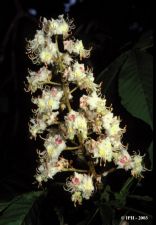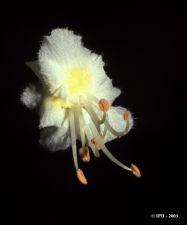Horse chestnut (Aesculus hippocastanum)
Family: Hippocastanaceae
Flowering: April - May
Description:
The tree may reach up to 20 meters height. The large and opposite leaves are petiolated and palmately lobed.
The trunk is brown and smooth but gradually becomes greyish-black, breaking up the bark. The flowers are erect and hermaphrodite, mainly white with a small pink spot. The seeds, called conkers or chestnuts, are contained by one or two in a greenish and spiky capsule.
Distribution:
The chestnut is attracted to sunlight, which so called heliophilia. It is mostly planted for ornamentation. Sometimes, it is subspontaneously found in maple and linden forests.
Allergy:
The horse chestnut pollen dispersal is mainly mediated by insects. This is why low pollen amounts are detected in the air. Occasional allergy to horse chestnut pollen is well-known, mainly among individuals living either in avenues where these trees are planted or near trees growing in open settings.








